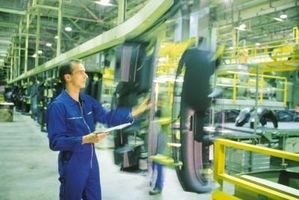Industrial Hazards & Safety

Industrial hazards are anything that jeopardizes employee welfare, and they must be addressed by safety measures. Identifying industrial hazards allows employers to protect their workers from accidents, injuries and fatalities.
Chemical Hazards and Safety
Chemicals found in industrial work environments have the potential to be hazardous. According to OSHA, the U.S. Occupational Safety and Health Administration, certain chemicals have dangerous reactivity properties that lead to fires, explosions, burns or blindness. OSHA requires employees to use personal protective equipment (PPE) when working with industrial chemicals. PPE, such as face shields and gloves, protects employees from direct exposure to chemicals.
Electrical Hazards and Safety
Electricity powers industrial machines and equipment. Adhering to OSHA’s electrical safety standards protects employees from shocks, electrocutions and fires. If electrical wires and cords are frayed or damaged, they must be replaced. Electrical devices should never be mixed with water or liquids, and only authorized employees should work with electrical equipment.
Machine Hazards and Safety
Industrial machines can cause severe injuries to employees. Crushed fingers, broken bones and severed limbs are potential safety hazards that industrial machines pose. To eliminate such risks, employers safeguard machinery. Covers, for instance, keep sharp machine edges or blades from being exposed. Also, locking machinery prevents it from moving when workers are not prepared.
Chemical Hazards and Safety
Chemicals found in industrial work environments have the potential to be hazardous. According to OSHA, the U.S. Occupational Safety and Health Administration, certain chemicals have dangerous reactivity properties that lead to fires, explosions, burns or blindness. OSHA requires employees to use personal protective equipment (PPE) when working with industrial chemicals. PPE, such as face shields and gloves, protects employees from direct exposure to chemicals.
Electrical Hazards and Safety
Electricity powers industrial machines and equipment. Adhering to OSHA’s electrical safety standards protects employees from shocks, electrocutions and fires. If electrical wires and cords are frayed or damaged, they must be replaced. Electrical devices should never be mixed with water or liquids, and only authorized employees should work with electrical equipment.
Machine Hazards and Safety
Industrial machines can cause severe injuries to employees. Crushed fingers, broken bones and severed limbs are potential safety hazards that industrial machines pose. To eliminate such risks, employers safeguard machinery. Covers, for instance, keep sharp machine edges or blades from being exposed. Also, locking machinery prevents it from moving when workers are not prepared.
- kqff109f742a1d0cbfacfb9bf8b5d5bed0.jpg